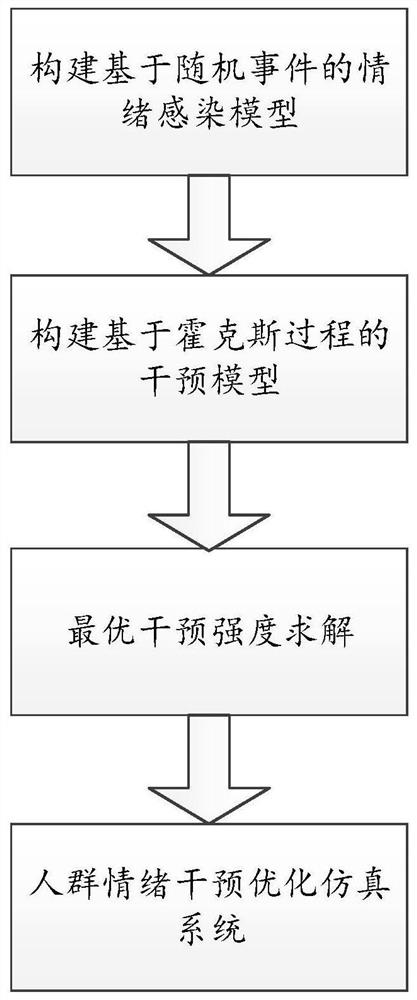Optimal intervention simulation method and system for panic emotion in crowd evacuation
A simulation method and optimization technology, applied in design optimization/simulation, artificial life, instruments, etc., can solve the problems of not considering the control of infection rate and recovery rate, adjusting the intensity of emotional intervention, and being unable to describe the randomness of the crowd, etc., to achieve real Visually analyze the effect of the effect
- Summary
- Abstract
- Description
- Claims
- Application Information
AI Technical Summary
Problems solved by technology
Method used
Image
Examples
Embodiment 1
[0045] The purpose of this embodiment is to provide an optimal intervention simulation method for panic in crowd evacuation.
[0046] Such as figure 1 As shown, an optimal intervention simulation method for panic in crowd evacuation, including:
[0047]Step 1: Establish a random event-based emotional contagion model (SEEC) to analyze the process of crowd emotional contagion;
[0048] Step 2: Establish a Hawkes process-based intervention model (HIEC), which can adaptively adjust the intervention intensity according to changes in the intensity of crowd events;
[0049] Step 3: Propose a maximum rate of return problem, and use the Artificial Bee Colony Optimization Intervention Emotional Contagion Algorithm (IE-ABC) to obtain the optimal solution. According to the current individual collision-free speed, perform crowd evacuation simulation movement;
[0050] Step 4: According to the current emotional intervention measures, the optimal intervention simulation of panic in crowd e...
Embodiment 2
[0106] The purpose of this embodiment is to provide an optimal intervention simulation system for panic in crowd evacuation.
[0107] An optimal intervention simulation system for panic in crowd evacuation, including:
[0108] A data collection module, which is used to obtain the data of the crowd evacuation process and determine the intensity of the incident;
[0109] Model construction module, which is used to construct an emotional infection model based on random events, quantify the process of crowd emotional infection according to the intensity of events; construct an intervention model based on the Hawkes process, through which the intervention model is based on the occurrence of crowd events Changes in intensity adaptively adjust intervention intensity;
[0110] The optimization solution module is used to construct the cost objective function of panic optimization, and use the artificial bee colony optimal intervention emotional infection algorithm to solve the optimal...
Embodiment 3
[0112] This embodiment also provides an electronic device, including a memory, a processor, and computer instructions stored in the memory and run on the processor. When the computer instructions are run by the processor, the above-mentioned panic in crowd evacuation can be completed. The optimal intervention simulation method of emotion, including:
[0113] Construct an emotional infection model based on random events, and quantify the process of crowd emotional infection according to the intensity of events;
[0114] Constructing an intervention model based on the Hawkes process, through which the intervention intensity is adaptively adjusted according to changes in the intensity of crowd events;
[0115] Construct the cost objective function of panic optimization, and use the artificial bee colony optimal intervention emotional infection algorithm to solve the optimal intervention intensity, and carry out crowd evacuation simulation movement according to the current individ...
PUM
 Login to View More
Login to View More Abstract
Description
Claims
Application Information
 Login to View More
Login to View More - R&D
- Intellectual Property
- Life Sciences
- Materials
- Tech Scout
- Unparalleled Data Quality
- Higher Quality Content
- 60% Fewer Hallucinations
Browse by: Latest US Patents, China's latest patents, Technical Efficacy Thesaurus, Application Domain, Technology Topic, Popular Technical Reports.
© 2025 PatSnap. All rights reserved.Legal|Privacy policy|Modern Slavery Act Transparency Statement|Sitemap|About US| Contact US: help@patsnap.com



